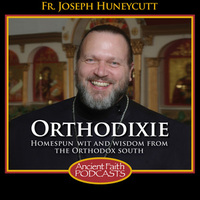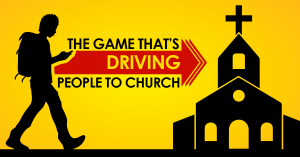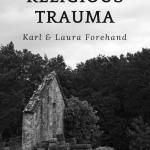 Chapter 55 of The Da Vinci Code is loaded. Lies, half truths, heresy, and partial sentences. But, who’s counting? It’s here that Dan Brown has one of the book’s main characters, Sir Leigh Teabing, lecture his subjects — thereby, us — on the falsity of the Christian faith (any faith), the evils of St Constantine, the glories of the divine feminine, the baseness of our Lord, and the near divinity of St Mary Magdalene. All this is to say, Chapter 55 is a doozy.
Chapter 55 of The Da Vinci Code is loaded. Lies, half truths, heresy, and partial sentences. But, who’s counting? It’s here that Dan Brown has one of the book’s main characters, Sir Leigh Teabing, lecture his subjects — thereby, us — on the falsity of the Christian faith (any faith), the evils of St Constantine, the glories of the divine feminine, the baseness of our Lord, and the near divinity of St Mary Magdalene. All this is to say, Chapter 55 is a doozy.
For previous posts: Part 1, Part 2, Addendum, Part 3, Part 4.
All of the source material for this section, unless otherwise noted, comes from an article by Carl E. Olson & Sandra Miesel for PLANET ENVOY (Parts 1 , 2).
“The Bible is a product of man, my dear. Not of God. The Bible did not fall magically from the clouds. Man created it as a historical record of tumultuous times, and it has evolved through countless translations, additions, and revisions. History has never had a definitive version of the book” (p.231).
The Bible … merely an historical record of tumultuous times? The following is taken from an article on the Great Canon of St Andrew of Crete:
[T]he Bible is not merely a history of the people of Israel. It is also a great chronicle of the soul of mankind, of the souls which would repeatedly fall and stand up again before the face of God, which repeatedly fell into sin and repeatedly repented. If we were to examine the lives of those mentioned in the Bible, we would see that each of them is presented not so much as a historical figure, an individual that did such and such, but as an individual standing before the Living God. The person’s historical or other accomplishments are accorded second place.
Brown’s stand alone [partial] sentence — “Not of God” — could serve as the motto for The Da Vinci Code. Sincerely. I challenge anyone to find within its pages any acknowledgement that there even is a God. With Dan Brown, “Not of God” is par for the course.
Brown’s right, though, the Bible did not fall magically from heaven. And of course, it was written by man. Yet, at least in the eyes of the Church, it is a record of God’s revelation to and relationship with, man. As for a “definitive version of the book,” the Bible is a collection of many books. And, as far as pre-Gutenberg Press ancient texts go, we do possess a pretty good accounting of the whos, whats, and wheres — if not, in some cases, the originals themselves. Teabing’s comment would play well in a Catechism class full of former Fundamentalists. Yet since Brown’s book seems pitted against the Roman Catholic Church, a polemic against Biblical Fundamentalists seems out of place. Then again, if those readers have followed him this far, they might just go all the way.
“More than eighty gospels were considered for the New Testament, and yet only a relative few were chosen for inclusion — Matthew, Mark, Luke, and John among them” (p.231)
As my Old Testament Prof used to say, “Well … that’s a stretch.” Or, “You can believe that if you want to.” Yet again, “Almighty God will let you believe any fool thing you want for as long as you want.” But, you get the picture.
We have no proof whatsoever that 80 “gospels” ever existed. By the mid-second century, before Constantine’s time, there were only 5 or 6 being considered. By the end of that century, the Church recognized the gospels of Matthew, Mark, Luke, and John as being divinely inspired.
As [Philip] Jenkins shows [in his book, The Hidden Gospels: How the Search for Jesus Lost Its Way (Oxford)], “the process of determining the canon was well under way long before Constantine became emperor, and before the church had the slightest prospect of political power. The crucial phase occurred in the mid-second century . . .” (p. 85).
In fact, there was already a growing consensus about the entire New Testament canon by the middle of the second-century, even though it would not be defined on an official (though not universal) level until the late-300s and early-400s in a series of local synods. Justin Martyr, writing around 150 A.D. and explaining the liturgy of the Christians to his non-Christian readers, speaks of the apostles and “the memoirs composed by them, which are called Gospels, have thus delivered unto us what was enjoined upon them” (“The First Apology,” 66). Tertullian, writing around the same time, defends the four Gospels, the Acts of the Apostles, thirteen Pauline epistles, the epistle to the Hebrews, and 1 John and The Apocalypse against the Gnostic ideas of Marcion (“Five Books Against Marcion,” 4.2, 4.5). A couple of decades later Irenaeus specifically refers to the four Gospels and their authors and implies that they are granted a unique status within the Church:
Matthew also issued a written Gospel among the Hebrews in their own dialect, while Peter and Paul were preaching at Rome, and laying the foundations of the Church. After their departure, Mark, the disciple and interpreter of Peter, did also hand down to us in writing what had been preached by Peter. Luke also, the companion of Paul, recorded in a book the Gospel preached by him. Afterwards, John, the disciple of the Lord, who also had leaned upon His breast, did himself publish a Gospel during his residence at Ephesus in Asia. (Against Heresies, 3.1.1)
A bit further on, Irenaeus writes, “It is not possible that the Gospels can be either more or fewer in number than they are” (3.11.8) and again prominently mentions Matthew, Mark, Luke, and John, further proof that that the number of gospels recognized as authoritative within the Church was set at four at least 150 years prior to Constantine and the Council of Nicaea.
“The Bible, as we know it today, was collated by the pagan Roman emperor Constantine the Great” (p.231)
Hogwash. Here’s what the Council of Nicea did do.
Here’s what it did not do: Establish a canonical list of books in the New Testament.
“[Constantine] was a lifelong pagan who was baptized on his deathbed, too weak to protest.” (p.232)
In seminary we were taught that Constantine, a consummate warrior, was afraid of being baptized for fear of sinning (in war) after baptism, thereby damning his soul. Besides, it was common in Constantine’s day for Christians to put off baptism till their deathbed because, in part, of the severe penances given for sins committed after baptism.
“[Constantine] had desired to be baptized in the waters of the Jordan River, where Jesus had been baptized, but it was not to be. Not long after the Easter of 337 he called together some bishops, removed his purple robe, and put on the white garments of a catechumen, then was baptized by Eusebius, the bishop of Nicomedia (Jones, 195-200). He died a few days later.”
“In Constantine’s day, Rome’s official religion was sun worship — the cult of Sol Invictus, or the Invincible Sun — and Constantine was its head priest. Unfortunately for him, a growing religious turmoil was gripping Rome. Three centuries after the crucifixion of Jesus Christ, Christ’s followers had multiplied exponentially. Christians and pagans began warring, and the conflict grew to such proportions that it threatened to rend Rome in two. Constantine decided something had to be done. In 325 A.D., he decided to unify Rome under a single religion. Christianity” (p.232).
Though Constantine may indeed have been a “sun-worshipper” …
“Romes official religion was not sun worship. “Rome’s official religion” states Dr. Margaret Mitchell, Associate Professor of New Testament and Early Christian Literature in the Divinity School at the University of Chicago, “was the cult of Roma ‘the goddess’ and of her deified emperors, and the Capitoline trio Jupiter, Juno and Minerva.
One of our Orthodox Christmas hymns reflects the Church’s “baptism” of the Sun cult:
Thy Nativity, O Christ our God, has shone upon the world with the light of knowledge: for thereby they who adored the stars through a star were taught to worship Thee, the Sun of Righteousness, and to know Thee, the Dayspring from on high. O Lord, glory to Thee.
We find the origin of the winter feast of the Nativity not in the historical facts available concerning the birth of Christ, but in a curious astronomical phenomenon. In late December we reach the shortest day of the year with more hours of darkness than daylight. From this point the hours of daylight become gradually longer. This observable phenomenon was given a religious significance in the pagan Roman world. It became the feast of Sol Invictus (the Unconquerable Sun). It was popularly celebrated in Rome during the last two weeks of December as Saturnalia. What better time for the Christians to celebrate the coming of the true unconquered “Sun”? Thus the feast of Christmas was born; the celebration of the dawning on the world of the Sun of Righteousness.
The hymns of both Christmas and Epiphany reveal the origin of these days in the old winter festival of the Unconquered Sun. Note how many astronomical references we find in the Nativity Troparion: Christ is described as the “Sun” of Righteousness, who illumines those who worshipped stars (of which the physical sun is one). Jesus has come as the dawning from the East (as the sun does).
The Matins exapostilarion hymn speaks of: A newly risen day. Our Savior is the Dayspring from the East. Those who were in darkness and shadow found the Light.
Epiphany is still known as “ton Foton” (feast of Lights). Its hymns also concentrate on astronomical themes. In Vespers Christ is described as “Bestower of light,” who desires to give light to those in darkness. In the Matins of the feast we find: “With Thy light that never sets, shine forth, O Christ.” Taken from H E R E.
[True, there existed two warring factions threatening to split Constantine’s empire. But the factions were not Christians and Pagans — but two different camps of Christians (please see previous posts).
‘The vestiges of pagan religion in Christian symbology are undeniable. Egyptian sun disks became the halos of Catholic saints. Pictograms of Isis nursing her miraculously conceived son Horus became the blueprint for our modern images of the Virgin Mary nursing Baby Jesus. And virtually all the elements of the Catholic ritual — the miter, the altar, the doxology, and communion, the act of ‘God-eating’ — were taken directly from earlier pagan mystery religions” (p.232).
Halos, blue nimbuses, were used to show the divinity of the Emperor. Christians may have adopted the art device to show the glorification of the Saints — but I’m not too sure about Egyptian sun disks.
There’s only so many ways one can depict a Mother & Child, no matter what you believe. Yet, in the East, iconography depicts not a suckling Babe perched on the Virgin’s lap, but a little Man (in order to show that Christ was truly God and truly Man). Instead of reinventing the wheel, I’ll let the folks at PLANET ENVOY carry the rest of this section …
“First, it should … be noted that “mystery religions,” strictly speaking, did not come into existence until the end of the first century at the earliest, making it impossible for the first Christians to take, borrow, or steal much of anything from them. The word “miter,” or “mitre,” is derived from mitra, a Greek word meaning “turban” or “headband.” It is the liturgical head-dress and part of the insignia of the bishop (Oxford Dictionary of the Christian Church, 1096). It didn’t appear in the West until the middle of the tenth century and was not used by bishops in the East until after the fall of Constantinople in 1453. In the East it seems to have been derived the crowns worn by Byzantine Emperors; in the West is appears to have been a variation of unofficial hat, the camelaucum, worn by the Pope in processions. In both cases, the mitre has no connections with pagan mystery religions.”
Altars are a common element in most religions and there are over three hundred references to altars in the Old Testament. Thus, the first Christians, who were all Jewish, would hardly be new to the concept of an altar, especially when the altar in the Temple was a focal point of the Jewish religion. Not surprisingly, there are several references to altars in the New Testament, including references in the Gospels to the altar in the Temple (Matt 5:23-24; 23:18-20; Lk 1:11) and references in The Apocalypse to the heavenly altar in the throne room of God (Rev. 6:9; 8:3-5; 9:13; 11:1; 14:8; 16:7). There is also this passage in the epistle to the Hebrews: “We have an altar, from which those who serve the tabernacle have no right to eat” (Heb 13:10). It is likely a reference to the Eucharistic table of the Christians and a similar use of language was common among the early Church Fathers. For example, Ignatius of Antioch (d. c. 110), writing to the church at Philadelphia, states, “Take care, then, to partake of one Eucharist; for, one is the Flesh of Our Lord Jesus Christ, and one the cup to unite us with His Blood, and one altar, just as there is one bishop assisted by the presbytery and the deacons, my fellow servants. Thus you will conform in all your actions to the will of God” (Letter to the Philadelphians, par. 4). Other references to a Christian altar appear in the writings of Tertullian and Cyprian.
A doxology is simply a hymn or ascription of praise and glory (doxa = “glory”; logos = “word”). Almost all religions have statements about the glory and power of a deity, reflecting the natural human desire to recognize what is sacred and Other. Traditionally, in historic Christianity, there are three types of doxology: the Great Doxology, the Less Doxology, and the Metrical Forms. Langdon is probably referring to the Great Doxology, which begins with these statements of praise:
Glory to God in the highest and on earth peace, good will to men.
We praise You; we bless You; we worship You; we glorify You; we thank You, for Your great glory.
O Lord King, God in Heaven, the Father Almighty. O Lord, Only-Begotten Son, Jesus Christ and Holy Spirit.
O Lord God, Lamb of God, the Son of the Father, Who takes away the sin of the world, have mercy on us; You, Who takes away the sins of the world;
Receive our prayers, You, Who sits at the right hand of the Father, and have mercy on us .
For You alone are Holy; You alone are the Lord, Jesus Christ, to the glory of God, the Father. Amen.
All of this language is taken directly from passages in the New Testament; all of it reflects the unique beliefs of the Christians. Such language did not, of course, come from pagans, who were mostly polytheistic and did not believe in the Trinity or the divinity of Jesus Christ.
Next time, in Part 6, we’ll begin with this Da Vinci Code doozy:
“Nothing in Christianity is original. The pre-Christian God Mithras — called the Son of God and the Light of the World — was born on December 25, died, was buried in a rock tomb, and then resurrected in three days. By the way, December 25 is also the birthday of Osiris, Adonis and Dionysus. The newborn Krishna was presented with gold, frankincense, and myrrh. Even Christianity’s weekly holy day was stolen from the pagans” (p.232).











